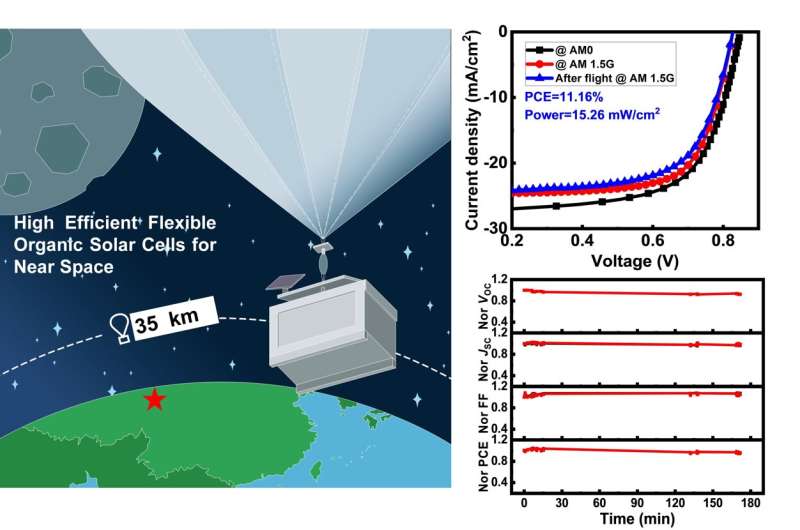This article has been reviewed according to Science X's editorial process and policies. Editors have highlighted the following attributes while ensuring the content's credibility:
fact-checked
trusted source
proofread
Using flexible organic solar cells in the stratosphere

Near-space aircraft and pseudo high-altitude satellites in the stratosphere have a wide application in environmental monitoring, disaster relief and mitigation, agricultural and forestry monitoring, resource exploration, and communication. Solar energy is the best energy source for near-space aircraft and pseudo high-altitude satellites.
Unlike on Earth, solar panels for space application should have a high power-per-weight ratio with excellent reliability in the stratosphere environment, which are essential to reduce the overall weight of the power system and consequently increase the payload and endurance of the aircraft.
In comparison with the mature solar cell technologies, the emerging nano-thin film solar cells, including organic solar cells and perovskite solar cells are very attractive for aerospace applications owing to the features of high power-per-weight ratio and excellent flexibility that is originating from the ultrathin layered structure.
Though conceptual proof of the performance in the stratosphere and satellite altitudes were carried out using high altitude balloons or a rocket flight, respectively, no research on in-situ performance and stability test of the large-area flexible organic solar cells (FOSCs) in the stratosphere environment was reported
Scientists from Suzhou Institute of Nano-Tech and Nano-Bionics and Aerospace Information Research Institute, Chinese Academy of Sciences, National Center for Nanoscience and Technology, explored the in-situ performance and stability of large-area FOSCs in the 35 km stratosphere environment by a high-altitude balloon.
The non-fullerene flexible organic solar cells with a cell area of 0.64 cm2 were fabricated through a solution-processed route with gravure-printed PET/AgNWs as electrodes. Low-temperature performance, thermal cycling as well as UV-illumination tests in the lab were carried out to evaluate the performance of FOSCs under the simulated condition.
Further, in-situ measurement results showed the FOSCs gave the highest power density of 15.26 mW/cm2 and efficiency of 11.16% at 35 km under irradiation of AM0, corresponding to a power-per-weight ratio of 3.32 kW/kg. In addition, the flexible organic solar cells kept stable over 3-hour continuous flying at 35 km. These results are of great significance for the space solar cells and show the possibility of large-area FOSCs for space usage.
The findings are published in the journal National Science Review.
More information: Zihan Xu et al, In situ performance and stability tests of large-area flexible polymer solar cells in the 35-km stratospheric environment, National Science Review (2022). DOI: 10.1093/nsr/nwac285

















